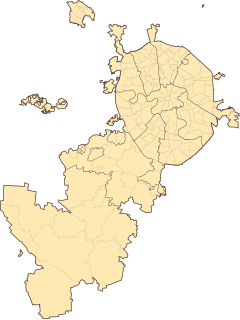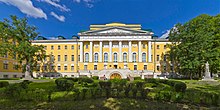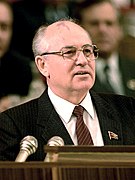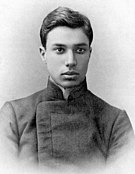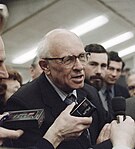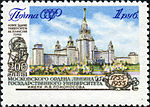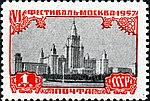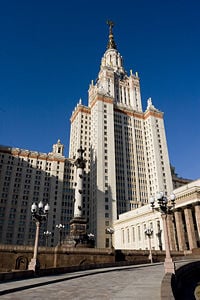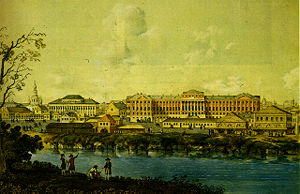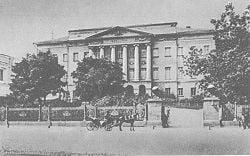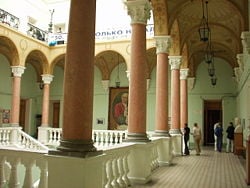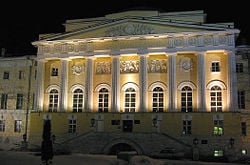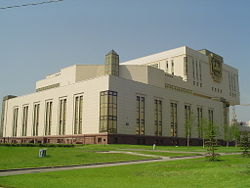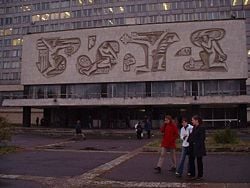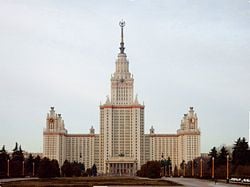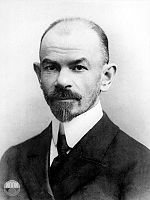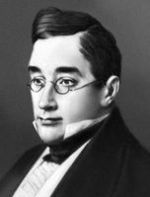Mikhail Lomonosov was one of the intellectual titans of the XVIII century. His interests ranged from history, linguistics and poetry to mechanics, astronomy, chemistry and mineralogy. Alexander Pushkin described him as a person of formidable willpower and keen scientific mind whose lifelong devotion was studying. Today Lomonosov is often called the Russian Leonardo da Vinci. He made major discoveries in physics and chemistry and founded the first Russian chemical laboratory at the Academy of Sciences in St. Petersburg. Lomonosov authored many well-known pieces of poetry, gained fame as an inventor of optic devices, perfected glass-making technology, explained the development of icebergs, proved the law of mass conservation and the kinetic theory of gases.
Lomonosov’s activity is a manifestation of the colossal potential of the Russian scientific community. After the reform of Peter I the country had a chance to reach the standard of the contemporary European powers in many spheres. Great importance was placed on education. It was Mikhail Vasilievich who was keen to improve its quality in Russia and suggested in his letter to Count Shuvalov the idea of establishing a university in Moscow accessible to all social groups. An influential courtier and the favourite of Empress Elizaveta Petrovna, the patron of arts and science Count Ivan Shuvalov supported Lomonosov’s plans for a new university and presented them to the Empress and the Senate.
In 1755, on the 25th of January (St. Tatiana’s Day according to the Russian Orthodox calendar) the Empress signed a decree that a university should be founded in Moscow. The opening ceremony took place on the 26th of April when Elizaveta’s coronation day was celebrated. Only one hundred students initially attended the university and its affiliated college. Since 1755 the 25th of January is celebrated as Students’ Day in Russia and the 26th of April is also marked by special events and festivities at the Moscow State University (MSU).
Today the University bears Lomonosov`s name and is considered one of the best universities in Russia. It has 40 Research Institutes and Centres. In total there are more than 40 thousand students, about 3 thousand students in overseas branches and about 6 thousand professors and teachers. There are 377 departments and about 1 million square metres of academic and research space at MSU.
Перевод
Михаил Ломоносов был одним из интеллектуальных титанов 18 века. Его интересы простирались от истории, лингвистики и поэзии до механики, астрономии, химии и минералогии. Александр Пушкин описывал его как человека внушительной воли и глубокого аналитического ума, чьей непреходящей любовью была учеба. Сегодня Ломоносова нередко называют русским Леонардо да Винчи. Он сделал значительные открытия в физике и химии и основал первую русскую химическую лабораторию в Академии Наук Санкт Петербурга. Ломоносов стал автором многих известных стихотворений, получил славу как изобретатель оптических приборов, усовершенствовал технологию производства стекла, объяснил феномен айсбергов, доказал закон сохранения массы и кинетическую теорию газов.
Деятельность Ломоносова является проявлением громадного потенциала русских научных кругов. После реформы Петра I в стране появилась возможность достичь стандартов современных европейских держав во многих сферах. Большое внимание уделялось образованию. И именно Михаил Васильевич горел желанием улучшить его качество в России и выдвинул в своем письме графу Шувалову идею создания университета в Москве, доступного для всех социальных слоев. Влиятельный придворный и фаворит императрицы Елизаветы Петровны, меценат, граф Иван Шувалов поддержал планы Ломоносова в отношении нового университета и представил их императрице и Сенату.
В 1755 году, 25 января (в День св.Татьяны согласно русскому православному календарю) императрица подписала указ об основании университета в Москве. Церемония открытия прошла 26 апреля во время празднования коронации Елизаветы. Первоначально лишь сотня студентов посещала университет и его филиал. С 1755 года в России 25 января празднуется как День студента, а 26 апреля также отмечается особыми событиями и празднованиями в Московском Государственном Университете (МГУ).
Сегодня Университет носит имя Ломоносова и считается одним из лучших университетов в России. В нем 40 Исследовательских институтов и центров. В общей сложности, в нем более 40 тысяч студентов, около 3 тысяч студентов на зарубежных отделениях и около 6 тысяч профессоров и преподавателей. В МГУ 377 отделений и около 1 миллиона квадратных метров учебно-исследовательских площадей.
Михаил Ломоносов и Московский Государственный Университет (Mikhail Lomonosov and Moscow State University) — 5.0 out of
5
based on
5 votes
- Текст
- Веб-страница
Moscow State University is the oldest, autonomous, self-governing and state-supported institution of higher learning, founded in 1755 by the scientist Mikhail Vasilyevich Lomonosov. Located in Moscow, the university is composed of faculties of biology, chemistry, computational mathematics and cybernetics, economics, foreign languages, fundamental medicine, geography, geology, history, journalism, law, mechanics and mathematics, physics, psychology, sociology, and soil sciences, as well as an institute of Asian and African Studies. Several museums, colleges, and a number of institutes are affiliated with Moscow University, and a preparatory faculty teaches Russian language and other subjects to foreign students.
Except for the science faculties and some of the arts faculties — which are situated in south-western Moscow — the remainder of the faculties are located in the older university buildings in the centre of the city. A diploma in a given field of study is awarded after five or five and a half years of study. After three additional years and the completion of a thesis, the kandidat nauk degree is awarded. The highest degree, the Doctor of Sciences, may be attained upon completion of a thesis based on independent research.
0/5000
Результаты (русский) 1: [копия]
Скопировано!
Московский государственный университет является старейшим, автономных, самоуправления и государственной поддержке вуза, основан в 1755 году ученый Михаил Васильевич Ломоносов. Расположен в Москве, Университет состоит из факультеты биологии, химии, вычислительной математики и кибернетики, экономики, иностранных языков, фундаментальной медицины, география, геология, история, журналистики, права, механики и математики, физики, психологии, социологии и почвоведения, а также Институт азиатских и африканских исследований. Несколько музеев, колледжи и целый ряд институтов связанных с Московского университета, и Подготовительный факультет учит русский язык и другие предметы для иностранных студентов.За исключением естественных факультетов и некоторые из искусств факультетов — которые находятся в юго-западной части Москвы — оставшуюся часть факультетов расположены в старых зданиях университета в центре города. Диплом в данной области исследования присуждается после пяти или пять с половиной лет учебы. После трех дополнительных лет и завершение диссертации присуждается степень кандидата наук. Высшей степени, доктор наук, может быть достигнута по завершении диссертацию на основании независимых исследований.
переводится, пожалуйста, подождите..
Результаты (русский) 3:[копия]
Скопировано!
московский государственный университет является старейшим, автономного самоуправления и государственной поддержки высшим учебным заведением, основанная в 1755 году учеными михаил васильевич ломоносов.расположен в москве, университета входят факультеты, биологии, химии, вычислительной математики и кибернетики, экономики, иностранных языков, основных медикаментов, географии, геологии, истории, журналистики,права, механики и математики, физики, психологии, социологии и почвоведения, а также институт азиатских и африканских исследований.некоторые музеи, колледжи, и ряд учреждений, связанных с московским университетом, и подготовительный факультет учит русский язык и другие предметы для иностранных студентов.
за исключением некоторых факультетов и филологических факультетов, которые расположены на юго — западе москвы — оставшуюся часть факультетов расположены в старых университетских зданий в центре города.диплом в данной области исследования производится через пять — пять с половиной лет исследований.после того, как дополнительные три года и завершения докторской диссертации,о степени кандидата наук присуждается.в наибольшей степени, доктор наук, может быть достигнута после завершения докторской диссертации на основе независимых исследований.
переводится, пожалуйста, подождите..
Другие языки
- English
- Français
- Deutsch
- 中文(简体)
- 中文(繁体)
- 日本語
- 한국어
- Español
- Português
- Русский
- Italiano
- Nederlands
- Ελληνικά
- العربية
- Polski
- Català
- ภาษาไทย
- Svenska
- Dansk
- Suomi
- Indonesia
- Tiếng Việt
- Melayu
- Norsk
- Čeština
- فارسی
Поддержка инструмент перевода: Клингонский (pIqaD), Определить язык, азербайджанский, албанский, амхарский, английский, арабский, армянский, африкаанс, баскский, белорусский, бенгальский, бирманский, болгарский, боснийский, валлийский, венгерский, вьетнамский, гавайский, галисийский, греческий, грузинский, гуджарати, датский, зулу, иврит, игбо, идиш, индонезийский, ирландский, исландский, испанский, итальянский, йоруба, казахский, каннада, каталанский, киргизский, китайский, китайский традиционный, корейский, корсиканский, креольский (Гаити), курманджи, кхмерский, кхоса, лаосский, латинский, латышский, литовский, люксембургский, македонский, малагасийский, малайский, малаялам, мальтийский, маори, маратхи, монгольский, немецкий, непальский, нидерландский, норвежский, ория, панджаби, персидский, польский, португальский, пушту, руанда, румынский, русский, самоанский, себуанский, сербский, сесото, сингальский, синдхи, словацкий, словенский, сомалийский, суахили, суданский, таджикский, тайский, тамильский, татарский, телугу, турецкий, туркменский, узбекский, уйгурский, украинский, урду, филиппинский, финский, французский, фризский, хауса, хинди, хмонг, хорватский, чева, чешский, шведский, шона, шотландский (гэльский), эсперанто, эстонский, яванский, японский, Язык перевода.
- Liquor Ammonii anisatus
- Вечером все тебе расскажу
- Merhaba Yusuf Bey,I hope that you are fi
- Кто из них работает в министерстве?
- Собаку зовут Тор
- Palpa et ausculta
- suam
- to record the findings
- Merhaba Yusuf Bey,I hope that you are fi
- Произведения М.Булгакова не подвластные
- mechanic
- Я надеюсь, что приготовлю все к тому вре
- დუღაბი
- Почему
- I heard the pierce on the tongue can cau
- culpam
- Она твоя девушка
- Новый» Хмельницкий (Константин Линартови
- Она твоя девушка?
- Кто из них работает в министерстве
- Отсань от меня мужчина
- Authentische Sprachvorbilder sind deshal
- МОему отцу 48 лет и он безработный
- Authentische Sprachvorbilder sind deshal
Moscow
State University is the oldest and one of the most prestigious
Russian institutions of higher education. It was established in 1755.
So on 25th
of January (St. Tatiana’s Day) 2015 Lomonosov Moscow State University
celebrated its 260th
anniversary.
In 1940 it was named after the outstanding
Russian
scientist Mikhail Lomonosov (1711 — 1765).
Nowadays
Moscow State University is a major traditional educational
institution in Russia. It offers training in almost all branches
of modern science and humanities. Its undergraduates may choose one
of 128 qualifications. Post-graduate students may specialize in 18
branches and in 168 different areas. The total number of MSU students
is more than forty thousand.
A
number of faculties offer four-year Bachelor’s and two-year
Master’s degree programs, together with traditional 5-year
Specialist degree programs. All the faculties provide the full-time
study. Post-graduate studies can be either full-time or part-time.
The applicants are enrolled
according to the results of entrance examinations (interviews and
tests).
Besides
its 39 faculties, Moscow University comprises 15 research institutes,
4 museums, the Science
Park,
the Botanical Gardens, The Library, the University Publishing House,
a recreational
centre
and a
boarding school
for talented children.
MSU
is a centre of research famous for its scientific schools. There have
been 11 Nobel Prize winners among its professors and alumni. MSU
graduates work in institutes of higher learning, research institutes,
in industry, governmental agencies, public organizations and private
companies.
Moscow
University campus
is an extremely complex system, with its 1,000 buildings and
structures and 8 halls of residence. Accommodation
in MSU halls of residence is provided for those students who are not
residents of Moscow.
Notes:
anniversary
[ˌænɪˈvɜːs(ə)rɪ]
– юбилей
outstanding
– выдающийся, знаменитый
Branch [brɑːntʃ] – отрасль, раздел (науки)
enroll
[ɪnˈrəʊl]
– зд. зачислять в вуз
Science
Park
– научный
парк,технопарк(обычно
при университетах)
recreational
centre
– зд. профилакторий
boarding
school
[ˈbɔːdɪŋˌskuːl]
– школа-интернат
campus
[ˈkæmpəs]
– университетский городок, территория
университета
accommodation
– жилье, место (для временного или
постоянного проживания)
Read
the text “Our University” and use it as a model for your own
topic.
Text e. Our Institute
The
Pedagogical Institute is one of the largest and oldest institutions
of higher education in Vologda Oblast. In 2008 it celebrated its 90th
anniversary. In 2014 the Pedagogical Institute became a structural
educational unit of Vologda State University.
Our
Institute has eight faculties which train teachers and specialists in
different subjects: Primary Education, Mathematics, Computer Science,
Physics, Chemistry, Biology, Geography, History, Management, Social
Science, Law, Russian Language and Literature, Foreign Languages,
Physical Education, Music, Psychology, Social Pedagogy and others.
About
seven thousand students are currently enrolled. The majority of them
are full-time students, the rest are part-time and correspondent
students.
Besides, some faculties provide post-graduate education. The course
of study for full-time students lasts five years for specialists and
four or five years for Bachelors. You have to study another two years
to be awarded a Master’s degree.
If
you are a rather active person you can take part / participate in the
work of our Students’ Council and improve the students’ social
life. For those who go in for sports there are a lot of sports
societies. You can also display your talents and take part in
different concerts and contests.
Our
Institute has six buildings. The faculty of Russian Language and
Literature is situated in Prospekt Pobedy Street. There is a library,
two reading-rooms, several computer centers, lecture halls,
laboratories and gyms at our Institute. The students and teachers of
our Institute usually have dinner at the refectory which is also
located in our building. The food there is rather tasty and
affordable (cheap). Besides, there are several cafes and food-stalls
in other buildings. You can also buy all sorts of drinks and snacks
in the drinks machine on the ground floor of every building.
The
Institute provides halls of residence for students who are not from
Vologda and can’t rent a room or a flat.
Соседние файлы в предмете [НЕСОРТИРОВАННОЕ]
- #
- #
- #
- #
- #
- #
- #
- #
- #
- #
- #
|
Московский государственный университет имени М. В. Ломоносова |
|
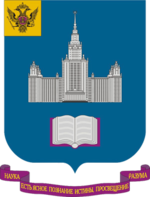
Coat of Arms |
|
| Motto |
Наука есть ясное познание истины, просвещение разума |
|---|---|
|
Motto in English |
Science is a clear knowledge of the truth, enlightenment of the mind |
| Type | Public research university |
| Established | 23 January 1755; 267 years ago |
| Rector | Viktor Sadovnichiy |
|
Academic staff |
5,000 |
| Students | 47,000 |
| Undergraduates | 40,000 |
| Postgraduates | 7,000 (estimate) |
| Location |
Moscow , Russia |
| Campus | Urban |
| Language | Russian |
| Colours | Blue |
| Affiliations | Association of Professional Schools of International Affairs (cancelled in 2022) Institutional Network of the Universities from the Capitals of Europe (suspended in 2022) International Forum of Public Universities |
| Website | www.msu.ru/en/ |
|
Building details |
|
|
Главное здание МГУ (ГЗ МГУ) |
|
 |
|
|
Location within Moscow |
|
| General information | |
| Location | Moscow, Russia |
| Coordinates | 55°42′14″N 37°31′43″E / 55.7039°N 37.5286°ECoordinates: 55°42′14″N 37°31′43″E / 55.7039°N 37.5286°E |
| Completed | 1953 |
| Height | |
| Architectural | 240 m (787 ft) |
| Top floor | 214 m (702 ft)[1] |
| Technical details | |
| Floor count | 42 |
| Floor area | 1,000,000 m2 (10,763,910.417 sq ft) |
M. V. Lomonosov Moscow State University (MSU; Russian: Московский государственный университет имени М. В. Ломоносова) is a public research university in Moscow, Russia and the most prestigious university in the country.[2][3][4]
The university includes 15 research institutes, 43 faculties, more than 300 departments, and six branches (including five foreign ones in the Commonwealth of Independent States countries). Alumni of the university include past leaders of the Soviet Union and other governments. As of 2019, 13 Nobel laureates, six Fields Medal winners, and one Turing Award winner had been affiliated with the university.
The university was ranked 18th by The Three University Missions Ranking in 2022, and 76th by the QS World University Rankings in 2022, #293 in the world by the global Times Higher World University Rankings, and #326 by U.S. News & World Report in 2022.[5] It was the highest-ranking Russian educational institution by QS in 2020,[6] and according to the Nature Index in 2019 the highest ranked Russian university for research output.[7] Moscow State University is generally accepted as the leading higher educational institution in the former Soviet Union.[8]
History[edit]
Imperial Moscow University[edit]
The Principal Medicine Store building on Red Square that housed Moscow University from 1755 to 1787
Ivan Shuvalov and Mikhail Lomonosov promoted the idea of a university in Moscow, and Russian Empress Elizabeth decreed its establishment on 23 January [O.S. 12 January] 1755.
The first lectures were given on 7 May [O.S. 26 April]. Saint Petersburg State University and MSU each claim to be Russia’s oldest university. Though Moscow State University was founded in 1755, St. Petersburg which has had a continuous existence as a «university» since 1819 sees itself as the successor of an academy established on in 1724, by a decree of Peter the Great.[citation needed]
MSU originally occupied the Principal Medicine Store on Red Square from 1755 to 1787. Catherine the Great transferred the university to a building on the other side of Mokhovaya Street, constructed between 1782 and 1793, to a design by Matvei Kazakov, and rebuilt by Domenico Giliardi after fire consumed much of Moscow in 1812.[citation needed]
Main buildings of the university in Mokhovaya Street, 1798
In the 18th century, the university had three departments: philosophy, medicine, and law. A preparatory college was affiliated with the university until its abolition in 1812. In 1779, Mikhail Kheraskov founded a boarding school for noblemen (Благородный пансион) which in 1830 became a gymnasium for Russian nobility. The university press, run by Nikolay Novikov in the 1780s, published the newspaper in Imperial Russia: Moskovskie Vedomosti.[citation needed]
In 1804, medical education split into clinical (therapy), surgical, and obstetrics faculties. During 1884–97, the Department of Medicine built a medical campus in Devichye Pole, between the Garden Ring and Novodevichy Convent; designed by Konstantin Bykovsky, with university doctors like Nikolay Sklifosovskiy and Fyodor Erismann acting as consultants. The campus, and medical education in general, were separated from Moscow University in 1930. Devichye Pole was operated by the independent I.M. Sechenov First Moscow State Medical University and by various other state and private institutions.[citation needed]
The roots of student unrest in the university reach deep into the nineteenth century. In 1905, a social-democratic organization emerged at the university and called for the overthrow of the Czarist government and the establishment of a republic in Russia. The imperial government repeatedly threatened to close the university. In 1911, in a protest over the introduction of troops onto the campus and mistreatment of certain professors, 130 scientists and professors resigned en masse, including Nikolay Dimitrievich Zelinskiy, Pyotr Nikolaevich Lebedev, and Sergei Alekseevich Chaplygin; thousands of students were expelled.[citation needed]
Moscow State University[edit]
1917-49[edit]
After the October Revolution of 1917, the institution began to admit children of the proletariat and peasantry. In 1919, the university abolished tuition fees, and established a preparatory facility to help working-class children prepare for entrance examinations. During the implementation of Joseph Stalin’s first five-year plan (1928–32), prisoners from the Gulag were forced to construct parts of the newly expanded university.
1950-99[edit]
A 1962 Soviet stamp features Moscow State University
In 1970, the university imposed a 2% quota on Jewish students.[9] A 2014 article entitled «Math as a tool of anti-semitism» in The Mathematics Enthusiast discussed antisemitism in the Moscow State University’s Department of Mathematics during the 1970s and 1980s.[10][11][12]
In the mid-1980s, the Dean of MSU’s law faculty was dismissed for taking bribes.[13] After 1991, nine new faculties were established. The following year, the university gained a unique status: it is funded directly from the state budget (bypassing the Ministry of Education).[citation needed]
On 6 September 1997, French electronic musician Jean Michel Jarre used the front of the university as the backdrop for a concert. The concert attracted a paying crowd of half a million people.[14]
2000-present[edit]
Students celebrating the 250th anniversary of the university in 2005
In 2007, MSU Rector Viktor Sadovnichy said that corruption in Russia’s education system was a «systemic illness,» and that he had seen an ad guaranteeing a perfect score on entrance exams to MSU, for a significant fee.[15]
On 19 March 2008, Russia’s most powerful supercomputer to date, the SKIF MSU (Russian: СКИФ МГУ; skif means «Scythian» in Russian) was launched at the university. Its peak performance of 60 TFLOPS (LINPACK — 47.170 TFLOPS) made it the fastest supercomputer in the Commonwealth of Independent States.[16][17]
In November 2012, Mikhail Basharatyan, Deputy Dean of the MSU World Economy Department, was fired for taking a bribe from a pupil.[18][19] In February 2013, Andrei Andriyanov resigned as head of the Kolmogorov Special Educational and Scientific Center of the university, after an investigation concluded that he had included fake references in his doctoral thesis.[20]
In March 2022, Victor Sadovnichy, rector of Moscow State University and president of the Russian Union of Rectors, was the lead signature in a public statement endorsing the 2022 Russian invasion of Ukraine.[21] In reaction, Academia Europaea, a pan-European academy, suspended the membership of Sadovnichy.[22] In response to the Russian invasion, that same month Yale University, the Hamburg University of Applied Sciences, University of Potsdam, and HKU Business School suspended their longstanding relationships with the university, and the University of St Andrews suspended a joint master’s degree programme with the university.[23][24][25][26][27] Intel and AMD, the largest chip manufacturers in the world, whose processors are used in the Moscow State University supercomputer, as well as NVIDIA, reacted by suspending deliveries of their processors to Russia.[28][29]
Campus[edit]
Building of the Faculties of Biology and of Soil Science
Since 1953, most of the faculties have been situated on Sparrow Hills, in southwest Moscow. In the post-war era, Joseph Stalin ordered seven tiered neoclassic towers to be built around the city. It was built using Gulag labour, as were many of Stalin’s Great Construction Projects in Russia.[30][31][32] The MSU main building was the tallest building in Europe until 1990. The central tower is 240 m tall, 36 stories high.[citation needed]
Along with the university administration, the Museum of Earth Sciences and faculties of Mechanics and Mathematics, Geology, Geography, and Fine and Performing Arts are in the Main building. The building on Mokhovaya Street houses the Faculty of Journalism, the Faculty of Psychology, and Institute of Asian and African Countries. A number of faculty buildings are located near Manege Square in the centre of Moscow and a number of campuses abroad in Ukraine, Kazakhstan, Tajikistan and Uzbekistan.[citation needed] The Ulyanovsk branch of MSU was reorganized into Ulyanovsk State University in 1996.[33]
Faculties[edit]
The first Humanities Building
As of 2015, the Old Building housed the Department of Oriental studies
As of 2009, the university had 39 faculties and 15 research centres. A number of small faculties opened, such as Faculty of Physics and Chemistry and Higher School of Television. The full list of faculties is as follows:[34]
- Faculty of Mechanics and Mathematics
- Faculty of Computational Mathematics and Cybernetics
- Faculty of Physics
- Faculty of Chemistry
- Faculty of Materials Science
- Faculty of Biology
- Faculty of Bioengineering and Bioinformatics [ru]
- Faculty of Soil Science [ru]
- Faculty of Geology [ru]
- Faculty of Geography
- Faculty of Fundamental Medicine
- Faculty of History
- Faculty of Philology [ru]
- Faculty of Philosophy [ru]
- Faculty of Economics
- Faculty of Law [ru]
- Faculty of Journalism
- Faculty of Psychology
- Institute of Asian and African Countries
- Faculty of Sociology [ru]
- Faculty of Foreign Languages and Area Studies [ru]
- Faculty of Public Administration [ru]
- Faculty of World Politics [ru]
- Faculty of Political Science
- Faculty of Fine and Performing Arts
- Faculty of Global Studies
- Faculty of Education
- Graduate School of Business Administration
- Faculty of Physics and Chemistry
- Moscow School of Economics
- Higher School of Translation and Interpretation
- Higher School of Public Administration
- Higher School of Public Audit
- Higher School of Administration and Innovations
- Higher School of Innovative Business Administration
- Higher School of Contemporary Social Sciences
- Higher School of Television
- Faculty of Further Education
- Faculty of Military Training
Institutions and research centers[edit]
- Skobeltsyn Institute of Nuclear Physics
- Institute of Mechanics
- Sternberg Astronomical Institute
- A.N. Belozersky Institute of Physico-Chemical Biology
- Research Computing Center
- N.N. Bogolyubov Institute for Theoretical Problems of Microphysics
- White Sea Biological Station
- Moscow University Herbarium
Academic reputation[edit]
| University rankings | |
|---|---|
| Global – Overall | |
| ARWU World[35] | 101–150 (2022) |
| QS World[36] | 75 (2023) |
| THE World[5][37] | 296 (2022) |
| USNWR Global[38] | 335 (2023) |
The main building in winter
In world rankings, MSU was ranked 101st–150th by the Academic Ranking of World Universities 2022,[39] #75 by QS World University Rankings 2023,[40] and #335 by U.S. News & World Report 2023.[41]
According to the some international rankings MSU is the highest-ranked Russian university (with the nearest Russian competitor being Saint Petersburg State University), but it was consistently ranked outside the top 5 nationally in 2010–11 by Forbes[42] and Ria Novosti / HSE,[43] with both ratings based on data set collected by HSE from Russian Unified State Exam scores averaged per all students and faculties of university.[citation needed]
The university has contacts with universities in the world, exchanging students and lecturers. It houses the UNESCO International Demography Courses and Hydrology Courses. In 1991 the French University College, the Russian-American University, and the Institute of German Science and Culture were opened.[citation needed]
| 2016 | 2015 | 2014 | 2013 | 2012 | 2011 | 2010 | 2009 | 2008 | 2007 | 2006 | 2005 | |
|---|---|---|---|---|---|---|---|---|---|---|---|---|
| Academic Ranking of World Universities[44] | 87th | 86th | 84th | 79th | 80th | 77th | 74th | 78th | 70th | 77th | 70th | 68th |
| QS World University Rankings[45] | 108th | 114th | 120th | 116th | 112th | 93rd | 101st | 183rd | 231st | 93rd | 93rd | |
| Times Higher Education World University Rankings[46] | 161st | 196th | 226-250th | 201-225th | 214th | 296th | 237th | – | – | – | – | – |
| Times Higher Education World Reputation Rankings[47] | 30th | 25th | 51-60th | 50th | – | 33rd | – | – | – | – | – | – |
| Human Resources & Labor Review (Graduates performance)[44] | – | 44th | 44th | 44th | 43rd | – | – | – | ||||
| Academic Ranking of World Universities (Natural Sciences)[44] | 51–75th | 51–75th | 51–75th | 51–75th | 51–75th | 51–75th | 53–76th | 41st | – | – | – | |
| QS World University Rankings (Natural Sciences)[47] | 60th | 34th | 84th | 44th | 38th | 29th | 30th | 29th | 27th | 44th | – |
Staff and students[edit]
The university employs more than 4,000 academics and 15,000 support staff.[citation needed] Approximately 5,000 researchers work at the university’s research institutes and facilities.[48] More than 40,000 undergraduates and 7,000 advanced degree candidates are enrolled.[48] Annually, the university hosts approximately 2,000 students, graduate students, and researchers from around the world.[citation needed]
Notable people[edit]
| Notable alumni of Moscow State University |
|---|
|
As of 2017, 13 Nobel laureates, 6 Fields Medal winners and one Turing Award winner had been affiliated with the university. It is the alma mater of writers such as Anton Chekhov, Boris Pasternak, and Ivan Turgenev, politicians such as Mikhail Gorbachev and Mikhail Suslov, as well as mathematicians and physicists such as Vladimir Arnold, Boris Demidovich, Vladimir Drinfeld, Vitaly Ginzburg, Andrey Kolmogorov, Grigory Margulis, Andrei Sakharov, and Yakov Sinai.
Moscow State University in philately[edit]
- Russian and Soviet stamps
-
1950 postage stamp:
the project of the 26-storey building of Moscow State University -
1955 postage stamp:
the old university building -
1955 postage stamp:
the new university building -
1957 postage stamp:
Moscow Festival of Youth and Students -
-
2005 postage stamp:
250th anniversary of Moscow State University
See also[edit]
- Education in Russia
- List of early modern universities in Europe
- List of universities in Russia
- List of rectors of Moscow State University
- List of honorary professors of the Moscow State University
References[edit]
- ^ «Where is Lomonosov Moscow State University, Moscow, Russia on Map Lat Long Coordinates». Latlong.net.
- ^ «Faculty of Physics». M. V. Lomonosov Moscow State University Faculty of Physics. Archived from the original on 2022-11-04. Retrieved 2022-11-04.
- ^ «Best Global Universities in Russia – US News and World Report». US News and World Report. Archived from the original on 2022-11-04. Retrieved 2022-11-04.
- ^ «Lomonosov Moscow State University – QS Top Universities Ranking». QS Top Universities Ranking. Archived from the original on 2022-11-04. Retrieved 2022-11-04.
- ^ a b «M. V. Lomonosov Moscow State University». Usnews.com. Retrieved 2022-07-25.
- ^ «QS World University Rankings 2020». Top Universities. June 5, 2019.
- ^ «2019 tables: Institutions | 2019 tables | Institutions | Nature Index». natureindex.com.
- ^ «Conference Venue». Worldslargerivers.boku.ac.at. Archived from the original on 2016-09-23.
- ^ Barry A. Kosmin. «Resentment, Anxiety and Careerism: Accounting for Antisemitism in the Academy and Among the Intelligentsia» (PDF). Isgap.org. Retrieved 2022-07-25.
- ^ Jay Egenhoff (2014). «Math as a tool of anti-semitism». The Mathematics Enthusiast. 11 (3). Retrieved 2022-07-25.
- ^ Malseed, Mark (May 6, 2013). «The Story of Sergey Brin». Momentmag.com.
- ^ Googled: The End of the World as We Know It. Penguin. 2009. ISBN 9781101151402.
- ^ The Emancipation of Soviet Law. Martinus Nijhoff Publishers. 15 October 1992. ISBN 9780792314363.
- ^ «Mad Max Fury Road: Ten Road Warrior themed world records». Guinness World Records. May 15, 2015.
- ^ Opening the Red Door: The Inside Story of Russia’s First Christian Liberal Arts University. InterVarsity Press. 17 September 2019. ISBN 9780830865178.
- ^ «8th edition of the Top 50 list of the most powerful computers in Russia released». Top500.org. TOP500 Supercomputing Sites. 2008-04-16. Archived from the original on 2011-09-27. Retrieved 2011-10-29.
- ^ «ru:В МГУ запустили мощнейший в СНГ компьютер». Km.ru. 2008-03-20. Retrieved 2016-07-14.
- ^ «Basharatyan fired from MSU for receiving bribe». en.vestikavkaza.ru.
- ^ Times, The Moscow (October 30, 2012). «Professors Caught Taking Hefty Bribe». The Moscow Times.
- ^ «Scandals Envelop Two Russian Science Officials; Allegations of a falsified dissertation lead to departure of head of special science high school». science.org.
- ^ «MILTA: Russian Colleges are calling for war. Will Yale react?». Yale Daily News. March 15, 2022.
- ^ «European infrastructures advised to block Russian access». Researchprofessionalnews.com. March 17, 2022.
- ^ «Yale Daily News: What Does the Future Hold for Russian Studies at Yale? | Russian, East European, & Eurasian Studies at Yale». Reees.macmillan.yale.edu.
- ^ «Exchange Partners | Undergraduate — FBE — HKU». ug.hkubs.hku.hk.
- ^ Kampfner, Constance. «Scottish universities’ Russian links come under urgent review». Thetimes.co.uk.
- ^ «Solidarity with Ukraine / Tolerance on our international campus» (PDF). Hasw-hamburg.de. Retrieved 2022-07-25.
- ^ Brodersen, Dr phil Silke. «University Partnerships». Uni-potsdam.de.
- ^ «AMD and Intel have suspended deliveries of their products to Russia – RBC». Time.news. February 26, 2022.
- ^ «What are the supercomputers of Sberbank, Yandex and MTS, the operation of which will be affected by the ban on NVIDIA software». Gadgetonus.com.
- ^ Figes, O. (2013) ‘Just Send Me Word – A True Story of Love and Survival in the Gulag’ pg. 192, Penguin Books: London.
- ^ Stalinist Reconstruction and the Confirmation of a New Elite, 1945-1953. Springer. 8 March 2001. ISBN 9781403919458.
- ^ Stalinism: Russian and Western Views at the Turn of the Millennium. Psychology Press. 2005. ISBN 9780415351089.
- ^ «Ulyanovsk state university, Fee structure 2022 Ulyanovsk State Medical University Admission». December 1, 2021.
- ^ «Подразделения МГУ». Msu.ru.
- ^ «Moscow State University – Shanghai Ranking». Shanghai Ranking.
- ^ «Top Universities». Top Universities.
- ^ «World University Rankings». insidehighered.com. 2019.
- ^ «Lomonosov Moscow State University – U.S. News & World Report». U.S. News & World Report.
- ^ «Moscow State University – Shanghai Ranking». www.shanghairanking.com. Retrieved 2022-12-03.
- ^ «Lomonosov Moscow State University». Top Universities. Retrieved 2022-12-03.
- ^ «Lomonosov Moscow State University – U.S. News & World Report». U.S. News & World Report. Retrieved 2022-12-02.
- ^ Самые сильные университеты России. Таблица. Forbes.ru.(2010) Retrieved on 2011-10-29.
- ^ Рейтинг качества приема в российские государственные вузы–2010 | Все рейтинги | Лента новостей «РИА Новости». RIA Novosti (2011-02-28). Retrieved on 2011-10-29.
- ^ a b c Moscow State University. Shanghairanking.com.
- ^ Lomonosov Moscow State University Archived October 2, 2011, at the Wayback Machine,Lomonosov Moscow State University. Topuniversities. Retrieved on 2011-10-29.
- ^ Top 200 – The Times Higher Education World University Rankings 2010–2011. Timeshighereducation.co.uk. Retrieved on 2011-10-29.
- ^ a b «World Reputation Rankings». Times Higher Education (THE). April 13, 2015.
- ^ a b «About MSU». www.journ.msu.ru.
External links[edit]
- Moscow State University
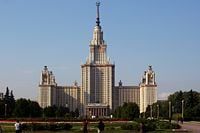
|
|
| Established | January 25, 1755 |
|---|---|
| Location | Moscow, Russia |
| Website | http://www.msu.ru/en/ |
M.V. Lomonosov Moscow State University (Russian: Московский государственный университет имени М.В.Ломоносова, often abbreviated МГУ, MSU, MGU) is the largest university in Russia, and claims to be the oldest. Founded in 1755, the university has grown to be one of the largest institutions in the world and has a long reputation both in and out of Russia for its education and research facilities, especially in the areas of science and mathematics.
Founded in 1755 by Mikhail Lomonosov, whose name was later added to the name of the institution in his honor, it was originally modeled after German universities with a largely German faculty. The university went through difficult times, as did Russia, with the prelude to the Revolution of 1917. After the revolution the university opened its doors to qualified students of all social classes, and efforts were made to assist those of the lower classes in attaining entrance qualifications. Subsequent political repressions negatively affected the development of scientific ideas, as Soviet scientists had virtually no contact with outside colleagues and only research compatible with Communist ideology was permitted. The institution again suffered difficulties due to the German invasion in World War II, but finally in the later part of the twentieth century solidified and expanded its position as a major academic force in not only Russia, but also Europe and the world. With a new charter adopted in 1998, the university has achieved not only substantial funding but a significant level of independence. In the twenty-first century, Moscow State University is expected to contribute greatly not only to the education of youth but also to the expansion of knowledge that will enable humankind to achieve a better quality of life.
Mission and Reputation
Moscow State University’s 1998 charter established «democracy, openness and self-government to be the main principles in the life of Moscow University; the main goal is freedom to teach and to study as well as to develop oneself as a personality.»[1] This reflects the long standing tradition of Moscow State as being the most prominent higher education institution in Russia.
It is disputed whether the Moscow State University or the St. Petersburg State University is the oldest higher education institution in Russia. While the former was established in 1755, the latter, which has been in continuous operation under the name of university since 1819, claims to be the successor of the university established on January 24, 1724 by a decree of Peter the Great together with the Academic Gymnasium and Saint Petersburg Academy of Sciences.
Moscow State University prides itself in its research facilities and projects, interdisciplinary programs in both the sciences and humanities as well as its high graduate and success rates. This reputation of excellence goes beyond Russia’s boundaries; in 2007, the Moscow State University was ranked 76th, out of 500, of the best World Universities[2], and number 23rd in all of Europe.[3]
History
Main buildings of the university in the Mokhovaya Street, 1798.
The university was established on the instigation of Ivan Shuvalov and Mikhail Lomonosov by a decree of Russian Empress Elizabeth dated January 25, 1755, which is still celebrated as Students’ Day in Russia.[4] First lessons were held on April 26. Originally located in the Principal Medicine Store on Red Square, the university was transferred by Catherine the Great to the present Neoclassical building on the other side of Mokhovaya Street. The main building was constructed between 1782 and 1793 to a Neo-Palladian design by Matvei Kazakov and rebuilt after Fire of Moscow (1812) by Domenico Giliardi. At this time the university had three faculties: philosophy, medicine, and law.
In 1804, medical education was split into Clinical (therapy), Surgical, and Obstetrics faculties. In 1884-1897, the Department of Medicine, supported by private donations, City Hall, and the national government, built an extensive, 1.6 kilometer long, state-of-the-art medical campus in Devichye Pole, between the Garden Ring and Novodevichy Convent.[5] In 1905, a social-democratic organization was created at the university calling for the tsar to be overthrown and for Russia to be turned into a republic. The Tsarist government repeatedly began closing the university. In 1911, in a protest over the introduction of troops onto the campus and mistreatment of certain professors, 130 scientists and professors resigned en masse, including such prominent names as Nikolay Dimitrievich Zelinskiy, Pyotr Nikolaevich Lebedev, and Sergei Alekseevich Chaplygin. Thousands of students were also expelled.
After the October Revolution in 1917, the school began opening admission to all qualified applicants, not just those of the wealthy. In 1919, tuition fees were done away with, and a preparatory facility was created for children of the working class so that they would be able to pass the admission examinations.[5] The political repressions of the 1930s and 1950s negatively affected the development of scientific ideas, as Soviet scientists had virtually no contacts with their colleagues abroad, while certain branches of science were condemned as based on the ideology alien to Communist ideas, and a number of scientists and scholars were sentenced to life imprisonment for their research efforts.
Moscow University in 1900
In 1940 the university was re-named in honor of its founder Mikhail Lomonosov, coinciding with the beginnings of World War II, another difficult time for the university. During the invasion of Russia by Nazi Germany, academic studies were suspended and most of the school was relocated far from the war front, yet hundreds of students and professors stayed to join the army and fought to protect the capital. Many researchers at the university stayed as well, carrying out programs to aid the war effort. After the war, lawyers from the university played a vital role in the Nuremberg and Tokyo trials.[5]
During the post-war period the leading role of Moscow University in the restoration and further development of the country was fully recognized. There was a fivefold increase in the state funding, the new University campus was built on Vorobievy Gory (Sparrow Hills), where all the lecture halls and laboratories had the latest equipment available at the time.
After 1991, nine new faculties were established. In 1992, a new charter was proposed and debated upon until 1998, when it was adopted. The result gave the university a unique status: it is funded directly from the state budget (bypassing the ministry of education) which provides a significant level of independence.[5]
Facilities
Since 1953, most of the faculties have been situated on Sparrow Hills, in the southwest of Moscow. The Main building was designed by architect Lev Vladimirovich Rudnev.[6] In the post-war era, Stalin ordered seven huge tiered neoclassic towers built around the city. The MSU Main building is by far the largest of these. It was also the tallest building in the world outside of New York City at the time of its construction, and it remained the tallest building in Europe until 1988. The central tower is 240m tall, 36-stories high, and flanked by four huge wings of student and faculty accommodations. It is said to contain a total of 33 kilometers of corridors and 5,000 rooms.[7] Facilities available inside the building include a concert hall, a theater, a museum, various administration services, a library, a swimming pool, a police station, a post office, a laundry, a hairdresser’s salon, a canteen, bank offices, shops, cafeterias, a bomb shelter, and so forth.
Today, the Old Building housed Departments of Psychology and Journalism.
Along with the university administration, four of the main faculties — Faculty of Mechanics and Mathematics, the Faculty of Geology, the Faculty of Geography, and the Faculty of Fine and Performing Arts — now remain in the Main building. The star on the top of the tower is large enough to include a small room and a viewing platform; it weighs 12 tons. The building’s facades are ornamented with giant clocks, barometers, and thermometers, statues, carved wheat sheaves, and Soviet crests (recently renovated). It stands before a terrace featuring statues of male and female students gazing optimistically and confidently into the future.
While the Sparrow Hills were on the outskirts of the city at the time of the construction of the Main building, they are now about halfway from the Kremlin to the city limits. Several other buildings and sports facilities were later added to the city campus, including the only baseball stadium in Russia.[8] At the beginning of the twenty-first century, construction began on a new building for the social sciences faculties, and a vast new facility was completed for the library, which is the second largest in Russia by volume (number of books). The university also has several dormitory buildings in the southwest of Moscow outside the campus.
Moscow State University Library
In addition to its many buildings, the MSU also houses several museums:
- Museum of Earth Science
- Anuchin Research Institute and Museum of Anthropology
- Museum of Zoology
- Museum of MSU History
Programs
The Moscow State University grants degrees in over fifty different areas of study, most of which fall into the humanities and science categories. In most of these areas, students are allowed to progress from undergraduate to the graduate and sometimes post-graduate level of study. In addition to Ph.D.s, the university also offers specialized medical and legal degrees.
Departments
Moscow State University’s main building
As of 2005, the university had 29 faculties:
- Faculty of Mechanics and Mathematics
- Faculty of Computational Mathematics and Cybernetics
- Faculty of Physics
- Faculty of Chemistry
- Faculty of Biology
- Faculty of Bioengineering and Bioinformatics
- Faculty of Soil Science
- Faculty of Geology
- Faculty of Geography
- Faculty of Materials Science
- Faculty of Fundamental Medicine
- Faculty of History
- Faculty of Philology
- Faculty of Philosophy
- Faculty of Economics
- Higher School of Business Administration
- Faculty of Law
- Faculty of Journalism
- Faculty of Psychology
- The Institute of Asian and African Studies
- Faculty of Sociology
- Faculty of Foreign Languages and Area Studies
- Faculty of Public Administration
- Faculty of Fine and Performing Arts
- Faculty of World Politics
- Faculty of Education
- Faculty of Further Education
- Moscow School of Economics
- Faculty of Military Training
- Department of Physical Education
The University also hosts several research centers and institutes of study, including:
- Scobeltsyn Nuclear Physics Research Institute
- Research Institute of Mechanics
- Shternberg State Institute of Astronomy
- Belozersky Research Institute of Physico-Chemical Biology
- Bogolubov Institute of Microworld
- MSU- RAS Research Institute of Soil Science
- Institute for Information Security Issues
- MSU Media Centre
- Center for International Education
- Kolmogorov Research Centre
- International Laser Centre
- Research Centre for Social Studies
- International Research Centre for Biochemical Technology
- Lyapunov Franco-Russian Centre for Applied Mathematics and IT technology
- Centre for Inservice Training for Specialists in Environmental Studies]
Student Life
As the largest school in Russia, and excepting a large number of international students, the students at the Moscow State University make-up a diverse population. This gives many native Russians a chance to live with and encounter people from different cultures, ethnicities, and religions, sometimes for the first time. It also gives international students the opportunity to live in and explore the Russian culture. However, since the university is so large, there is also the drawback that going to school there can be at times an impersonal experience; with large classrooms and a campus spread out over a large geographical area, the sense of community can at times be strained.
Located in the largest city in Russia, the university does give students the chance to live and explore Moscow, a modern cosmopolitan city full of history, culture, and excitement.
Traditions
Russian Students Day, (also known as Tatiana Day) is a Russian religious holiday observed on January 25 according to the Gregorian calendar. It is named after Saint Tatiana, a Christian martyr in second century Rome during the reign of Emperor Alexander Severus.
In 1755 on the name day of Ivan Shuvalov’s mother Tatiana Rodionovna, his mistress Empress Elizabeth of Russia endorsed his petition to establish the university in Moscow. The church of Saint Tatiana was later built in the university campus, and the Russian Orthodox Church declared Saint Tatiana the patron saint of students, and Tatiana Day has become celebrated as Russian Students Day.[9]
Famous alumni and faculty
- Alexey Abrikosov — Winner of 2003 Noble Prize winner in Physics
- Pavel Alexandrov — famous mathematician
- Zalpa Bersanova — famous author and Ethnographer
- Anton Chekhov — famous author
- Boris Chicherin — famous philosopher and Monarchist
- Ekaterina Dashkova — Princess in the Imperial Russian Court of the eighteenth century
- Dmitri Egorov — Famous mathematician
- Grigori Gamburtsev — Pioneer in Russian seismology studies
- Israel Gelfand — famous mathematician
- Vitaly Ginzburg — 2003 Noble Prize winner in Physics
- Mikhail Gorbachev — last General Secretary of the Communist Party of the Soviet Union, winner of 1990 Noble Peace Prize
- Alexandr Griboyedov — Russian diplomat, playwright, and composer
- Alexander Herzen — major Russian pro-Western writer and thinker known as the «father of Russian socialism.»
- Ion Iliescu — Former President of Romania
- Wassily Kandinsky — Early abstract artist
- Pyotr Kapitsa — Winner of 1978 Noble Prize for Physics
- Maxim Kontsevich — Winner of 1998 Fields Medal
- Igor Kurchatov — leader of the Soviet atomic bomb project
- Lev Landau — Winner of 1962 Noble Prize in Physics
- Grigory Margulis — Winner of 1978 Fields Medal
- Nitiphoom Naowarat — Journalist and politician of Thailand
- Aleksandr Oparin — Soviet biochemist and author of the theory of the origin of life
- Andrei Sakharov — eminent Soviet nuclear physicist, dissident and human rights activist, winner of 1975 Noble Peace Prize
- Yakov Sinai — one of the most influential mathematicians of the twentieth century
- Sergey Stanishev — Prime Minister of Bulgaria
- Igor Tamm — Nobel Laureate in Physics for the year 1958
Notes
- ↑ Lomonosov Moscow State University (2007) «MSU History» Retrieved November 24, 2007
- ↑ Institute of Higher Education, Shanghai Jiao Tong University (2007) «Top World Universities (1-99)» Retrieved November 24, 2007
- ↑ Institute of Higher Education, Shanghai Jiao Tong University (2007) «Top 100 European Universities» Retrieved November 24, 2007
- ↑ E. V. Anisimov. Empress Elizabeth: Her reign and her Russia, 1741-1761., (Academic International Press, 1995, ISBN 0875691404)
- ↑ 5.0 5.1 5.2 5.3 Lomonosov Moscow State University (2007) «MSU History» Retrieved November 24, 2007
- ↑ Garant-InfoCentre (2007) «Architect Lev Rudnev, the Author of the Colossus of MSU» Retrieved November 24, 2007
- ↑ Irina Chipova and Katharina Feuer (ed). Moscow Architecture & Design. (Te Neues Publishing Company, 2007, ISBN 3832791566)
- ↑ Mara Vorhees. Moscow. Lonely Planet City Guides. (Lonely Planet Publications, 2006, ISBN 1740598156)
- ↑ «Major Russian Holidays» flowers2Moscow.com (2007) Retrieved November 24, 2007
References
ISBN links support NWE through referral fees
- Anisimov, E.V. Empress Elizabeth: Her reign and her Russia, 1741-1761. Academic International Press, 1995. ISBN 0875691404
- Chipova, Irina and Katharina Feuer, (eds). Moscow Architecture & Design. Te Neues Publishing Company, 2007. ISBN 3832791566
- Vorhees, Mara. Moscow (Lonely Planet City Guides). Lonely Planet Publications, 2006. ISBN 1740598156
External links
All links retrieved November 10, 2022.
- Moscow State University campus on Google Maps
Credits
New World Encyclopedia writers and editors rewrote and completed the Wikipedia article
in accordance with New World Encyclopedia standards. This article abides by terms of the Creative Commons CC-by-sa 3.0 License (CC-by-sa), which may be used and disseminated with proper attribution. Credit is due under the terms of this license that can reference both the New World Encyclopedia contributors and the selfless volunteer contributors of the Wikimedia Foundation. To cite this article click here for a list of acceptable citing formats.The history of earlier contributions by wikipedians is accessible to researchers here:
- Moscow_State_University history
The history of this article since it was imported to New World Encyclopedia:
- History of «Moscow State University»
Note: Some restrictions may apply to use of individual images which are separately licensed.




